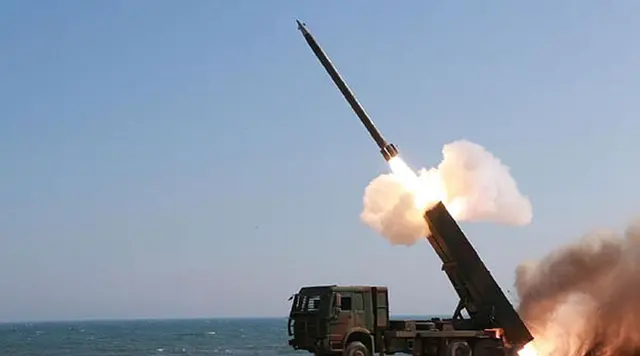The Democratic People's Republic of Korea (DPRK) fired one ballistic missile into east waters from its west region, South Korea's Joint Chiefs of Staff (JCS) said on Wednesday.
The projectile was launched eastward from South Hwanghae province at about 7:50 a.m. local time, a JCS official said on the phone. Further details are being analyzed, the official added.
The launch came after the DPRK test-fired two medium-range Rodong ballistic missiles and one shorter-range Scud missile on July 19 in an apparent protest against the decision between Seoul and Washington to deploy Terminal High Altitude Area Defense on South Korean soil.
An DPKR's ballistic missile. File photo
On July 8, South Korea and the U.S. abruptly announced an agreement to deploy one THAAD battery by the end of next year. Five days later, the deployment site was designated at Seongju county, some 250 km southeast of Seoul.
One day after the announcement, Pyongyang test-fired a submarine-launched ballistic missile (SLBM) off its east coast to demonstrate against the THAAD deployment decision. In times of military conflict, it is hard to detect and track SLBM with THAAD' s X-band radar.
THAAD is incapable of intercepting Rodong and Scud missiles targeting South Korea as the DPRK missiles travel at an altitude of 20-30 km. The U.S. anti-missile system is designed to shoot down missiles at a much higher altitude of 40-150 km.
The DPRK military has threatened to take"physical measures" against the THAAD deployment site. On July 19, Seoul's unification ministry said Pyongyang appeared to have been in a state of conducting another nuclear test at any time given increased activity in its main Punggye-ri nuclear test site.
THAAD. File photo
Japan condemned the missile launch by DPRK and lodged an official protest with Pyongyang saying the launch was in defiance of UN Security Council resolutions.
Defense Minister Gen Nakatani told a press briefing that what was believed to be a Nodong medium-range class ballistic missile flew for around 1,000 kilometers and landed in seas off Oga Peninsula, to the west of Akita Prefecture, in Northern Honshu.
Nakatani said that the missile landed within what Japan describes as its exclusive economic zone in the Sea of Japan and said his agency is currently "analyzing the situation."
The defense minister also said that his agency and the coast guard were currently determining whether any damage had been caused to aircraft vessels in the vicinity.
"The launch is in defiance of clear UN Security Council resolutions and is an extremely problematic act from the standpoint of securing the safety of aircraft and vessels at sea, "the Japanese government was quoted as saying in a statement.
Defense Minister Gen Nakatani. File photo
Nakatani ordered the nation's Self-Defense Forces (SDF) to be on high alert following the launch, which is believed to have taken place from an area in the South Hwanghae province which lies to the southwest of the DPRK capital Pyongyang and is the first such kind to have landed in what Japan believes to be its territorial waters.
The spate of recent launches, government officials here have said, have been a show of defiance against UN Security Council resolutions slapped on the DPRK for its ongoing nuclear and ballistic missile technology programs which are banned under the council's resolutions.
The DPRK in addition to a number of missile launches and attempts has also conducted four nuclear test which have also been resolutely condemned by Japan and the UN Security Council.
(APD)
 简体中文
简体中文

